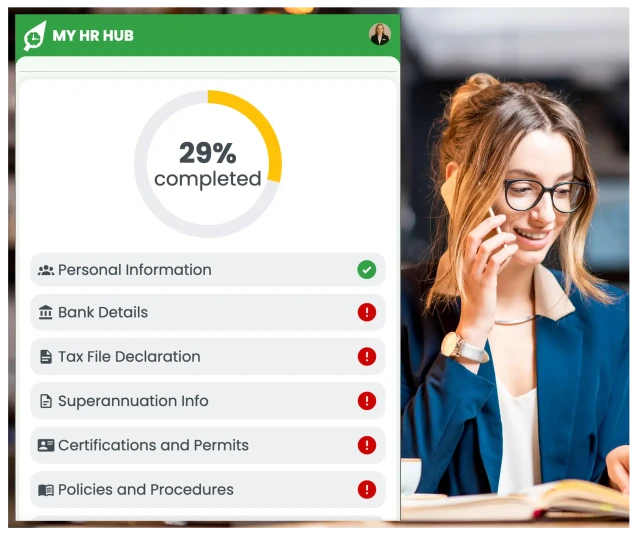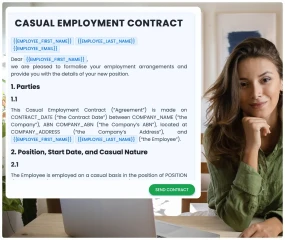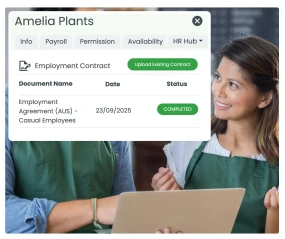Featured summary: Why digital contracts matter
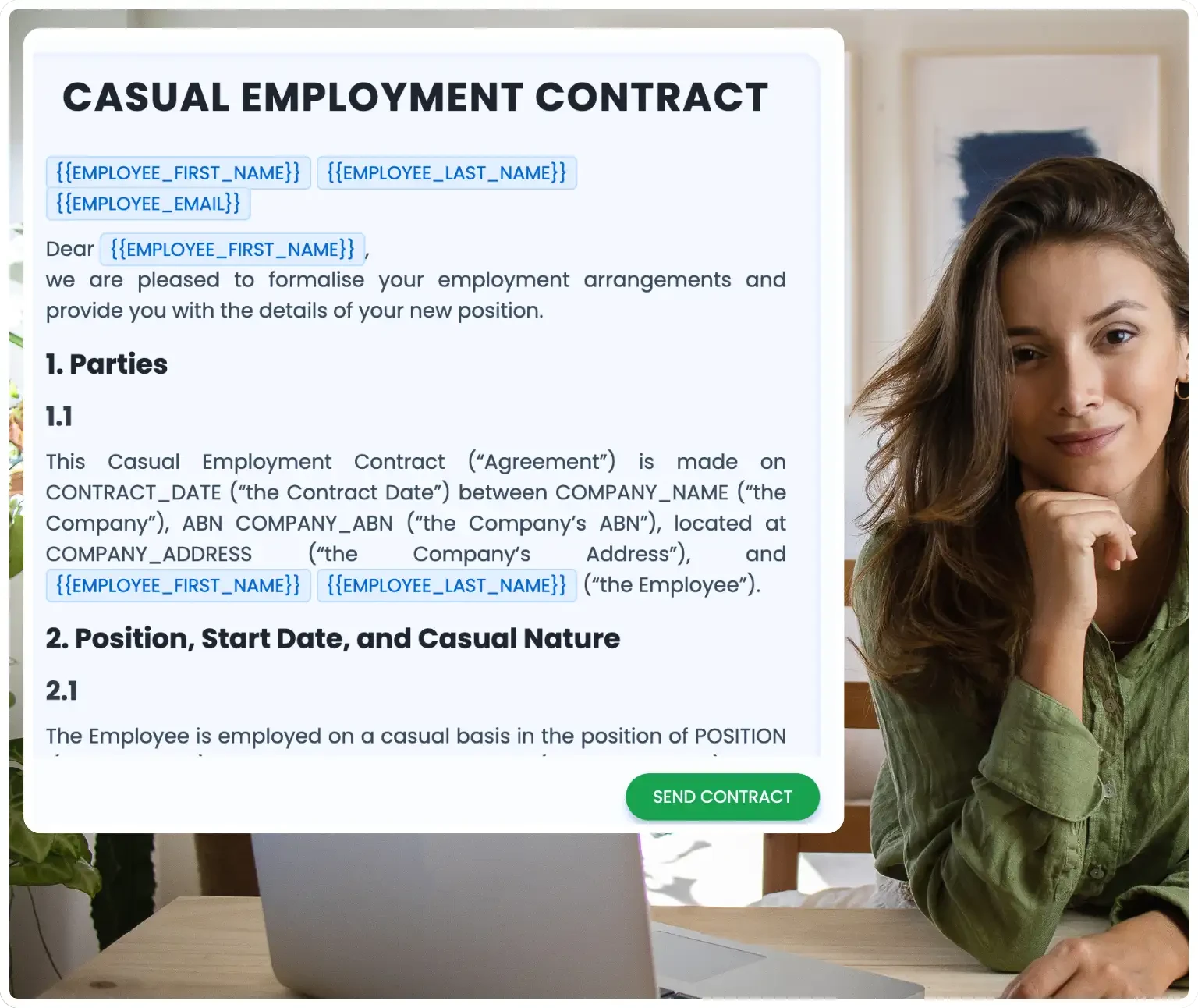
Why do you need digital employment contract software? Digital employment contract software speeds hiring, reduces errors and strengthens compliance. Send, sign and store agreements online with secure audit trails, standard templates and integrations to rostering and payroll. It gives HR fast, trackable workflows and gives employees a clear, mobile‑friendly experience.
In a world where business is increasingly digital, the way organisations engage, onboard and manage talent must evolve too. Employment contracts—once dusty paper folders—are undergoing a software‑led transformation. HR teams face tighter labour markets, greater compliance obligations and rising expectations for seamless technology. Digital employment contract software is no longer a “nice to have”; it is a strategic necessity for modern HR and operations.
The digital transformation of HR
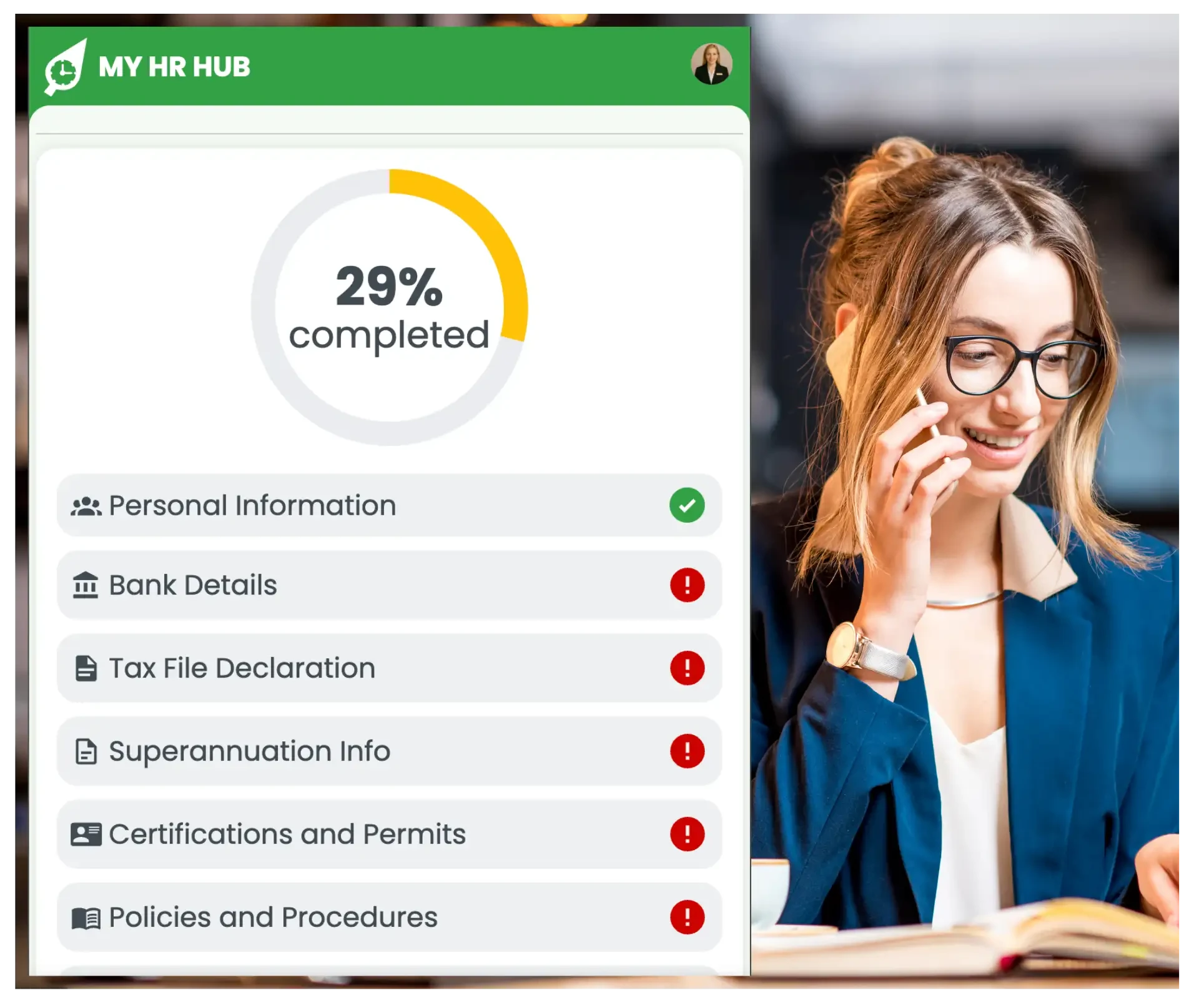
Paper‑based processes slow hiring, fragment compliance and frustrate candidates. By contrast, Digital employment contract software creates a single, reliable flow from offer to first shift: contracts are issued from approved templates, e‑signed with audit trails, stored securely and synced downstream to scheduling and payroll. The result is fewer delays, fewer errors and a stronger employee experience from day one.
Why this shift matters now
- Remote and hybrid work: dispersed teams make in‑person contract handovers impractical; digital workflows are essential for velocity.
- Compliance pressure: modern awards, enterprise agreements and privacy duties demand accuracy and traceability across every hire.
- Candidate expectations: mobile‑first experiences influence acceptance rates and employer brand.
- Operational resilience: digital records and standardised templates reduce key‑person risk and make audits straightforward.
For macro context, Australia’s labour market continues to evolve, and workforce composition data is tracked by the Australian Bureau of Statistics. Keeping HR processes fast and compliant helps businesses adapt quickly as conditions change.
Why digital contracts matter more than ever
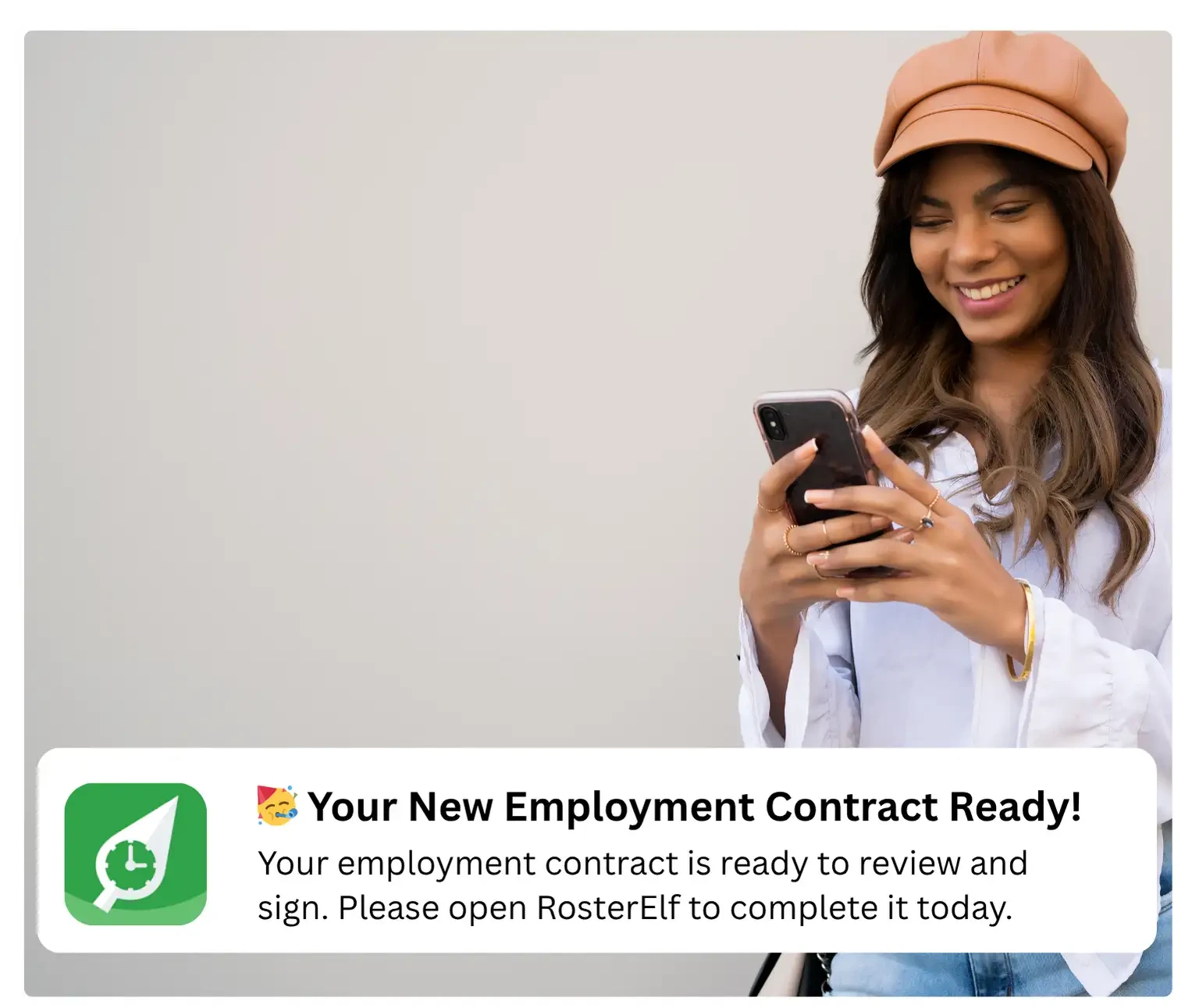
1) Remote, hybrid and distributed work
When teams are spread across suburbs, states or time zones, paper contracts cause delays and missed starts.Digital employment contract software enables same‑day offer letters, mobile signing and automated reminders—so the right people begin on time without manager chase‑ups.
2) From admin burden to strategic capability
Contract management is shifting from back‑office paperwork to an insights‑rich process. Dashboards show which contracts are unsigned or nearing expiry, and which clauses are frequently negotiated. HR and legal leaders can improve templates, reduce exceptions and create repeatable, defensible processes.
3) Legal enforceability has caught up
In Australia, the Electronic Transactions Act 1999 recognises electronic signatures where intent and consent are proven. Combined with clear audit trails and secure storage, e‑signatures provide robust evidence for HR record‑keeping and disputes.
4) Legal‑tech and automation are mainstream
Legal and HR functions increasingly adopt software to cut cycle times and standardise risk controls. The practical outcome for HR is faster onboarding, cleaner records and fewer manual steps between “offer accepted” and “first shift published”.
Core benefits: speed, accuracy and lower risk
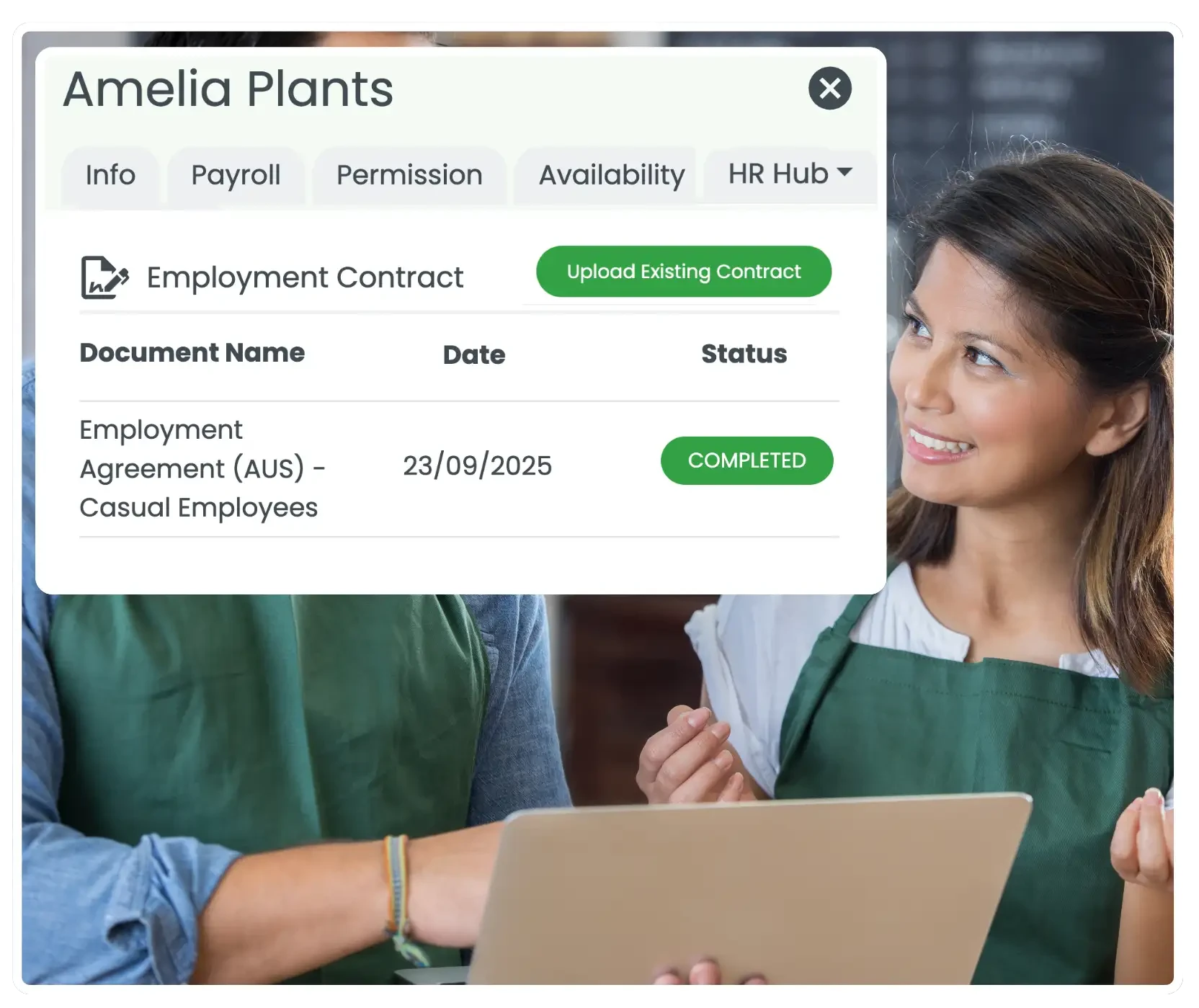
Faster onboarding and fewer bottlenecks
- Approved templates: HR create role‑specific contracts in minutes using pre‑loaded clauses.
- Mobile e‑signing: candidates review and sign on any device, with automatic reminders for outstanding actions.
- Instant visibility: managers see status (sent, viewed, signed) and can nudge the process without email trails.
Better compliance and governance
- Standard terms: consistent templates reduce the risk of missing mandatory clauses or using outdated language.
- Audit trails: timestamped records of who did what, when, and from which IP address build defensibility.
- Record‑keeping alignment: maintain accurate employment records in line with guidance from the Fair Work Ombudsman on employment contracts.
Secure storage and privacy
- Access controls: limit who can view, edit or download contracts.
- Retention policies: apply time‑bound retention in line with the Australian Privacy Principles.
- Encryption: protect documents in transit and at rest to reduce breach risk.
Collectively, these benefits lower cycle time and reduce compliance exposure while projecting a modern, professional employer brand.
Integration: connect contracts to rostering and payroll
Digital contracts become exponentially more valuable when they connect to the rest of your workforce stack. Once a candidate signs, their job details (role, classification, award level, base rate, allowances and availability) can flow straight into scheduling and payroll—eliminating re‑keying and preventing early pay errors.
Practical integration examples
- Rostering: use signed contract data (employment type, ordinary hours, location) to build fair, budget‑aware shifts in the rostering tool.
- Award rules: align pay conditions with award interpretation so overtime, penalties and allowances calculate correctly from day one.
- Payroll: push approved details to payroll integration for accurate first pays and fewer adjustments.
Tightly integrated workflows are not just convenient; they drive measurable reductions in admin time and error rates during the critical first weeks of employment.
Employee experience: clarity builds trust

Your contract process sets the tone for the entire employment relationship. Confusing PDFs, print‑and‑scan steps or lost attachments create friction. A clean digital flow shows respect for the candidate’s time and reduces uncertainty about entitlements, hours and start dates.
What great looks like for employees
- Mobile clarity: readable clauses and key facts summarised up front, with the full contract available on demand.
- Status transparency: candidates can see where the document is in the signing process, removing guesswork.
- Lifetime access: secure access to the final, signed version and related policies if needed later.
When employees experience clarity and fairness from day one, engagement and reliability improve—and that shows up in service quality and retention.
What to look for in digital employment contract software
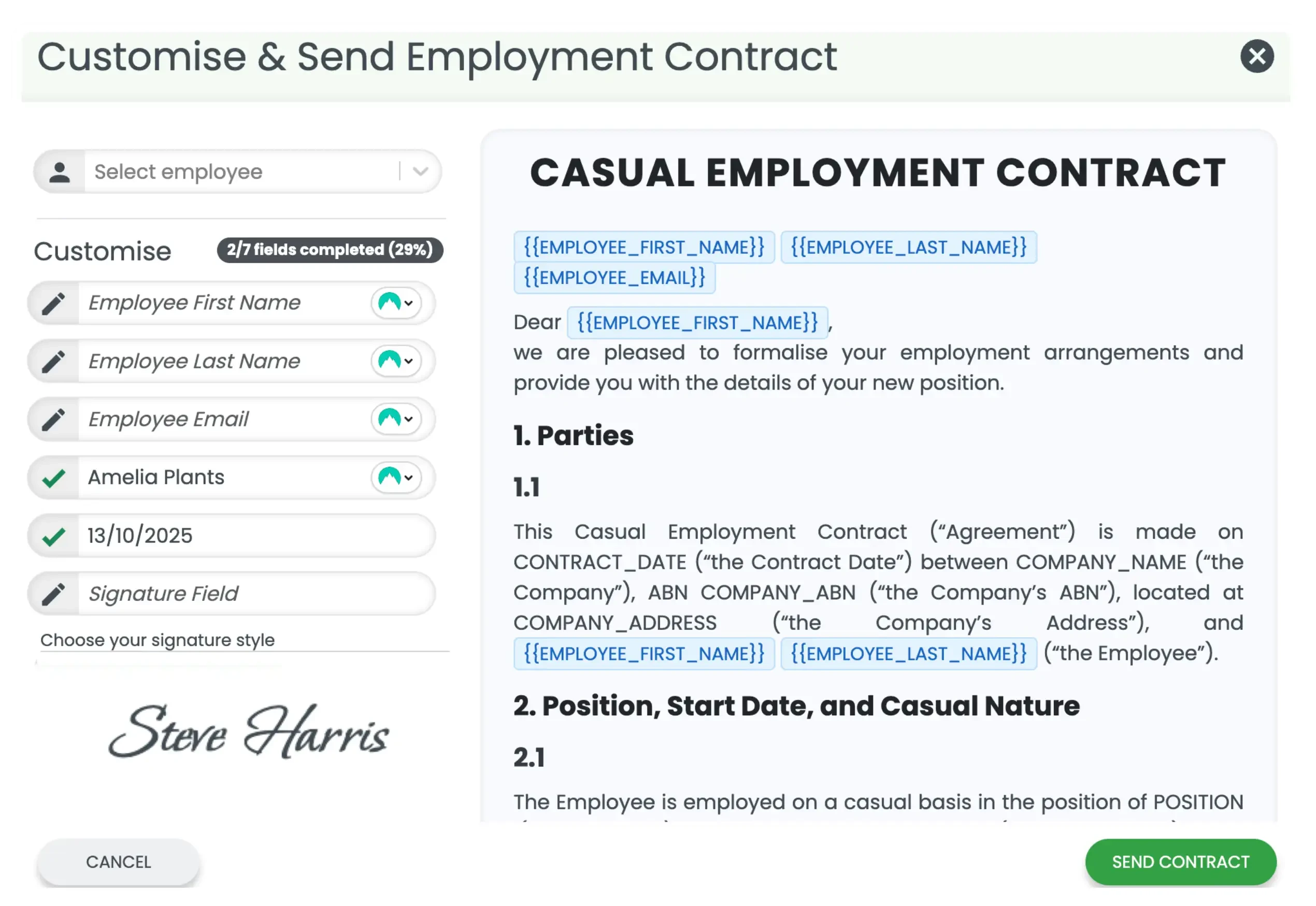
Compliance and security foundations
- Legally recognised e‑signatures: methods that support intent, consent and identity, aligned with the Electronic Transactions Act 1999.
- Immutable audit trails: every edit, view and signature logged with timestamps.
- Privacy by design: APP‑aligned processes per the OAIC, with encryption in transit and at rest.
Control and flexibility
- Template libraries: modular clauses, conditional logic and jurisdiction‑specific variants.
- Role‑based permissions: clear separation of drafting, approving and signing.
- Alerts and renewals: automatic reminders for expiries, probation reviews and re‑sign campaigns.
Integration and usability
- HRIS and payroll connectors: reduce re‑keying and ensure pay accuracy on day one.
- Rostering alignment: signed terms feed into shift patterns via smart rostering.
- Accessible UX: clean mobile interfaces for managers and candidates.
Evaluating against this checklist helps you separate convenient e‑sign tools from true employment‑grade contract platforms.
Handling common objections and barriers
Address resistance with facts and pathways
| Objection | How to address |
|---|---|
| “Paper feels safer and more official.” | Show tamper‑evident audit trails, encryption and restricted access. Explain how digital creates more evidence than paper. |
| “Regulators won’t accept e‑signatures.” | Point to the Electronic Transactions Act 1999 and the FWO guidance on contracts. |
| “Change will disrupt hiring.” | Run a phased rollout: start with one department or site, measure turn‑around time, then scale. |
| “Privacy and security risks.” | Outline APP‑aligned processes and reference the Australian Privacy Principles, including access controls and retention policies. |
| “Integration looks hard.” | Demonstrate connectors to payroll integration and rostering, with implementation support. |
Up‑front education and a tightly scoped pilot reduce anxiety and show tangible wins early.
Evidence that strengthens the business case
Leaders respond to data. While adoption rates vary by sector, several sources point to widespread digitisation and strong ROI for contract software. For official guidance on employment contracts, see the Fair Work Ombudsman. For workforce context and wage trends, refer to the Australian Bureau of Statistics labour statistics. Privacy duties for handling employee records are set out under the Australian Privacy Principles.
What these sources mean for HR
- Compliance is non‑negotiable: your contract process must produce accurate, discoverable records.
- Digital reduces cycle time: faster sign‑offs improve readiness for first shifts and service continuity.
- Integration prevents payroll errors: contract data feeding rosters and pay rules reduces rework and back‑pay risk.
Together, this evidence supports moving from ad‑hoc paperwork to a standardised, auditable digital pathway.
How RosterElf’s digital employment contract software helps
RosterElf brings HR, legal and operations into one streamlined flow. It gives managers clarity, legal teams defensibility and employees a professional, mobile‑first experience—backed by award‑aware rostering and accurate payroll hand‑offs.
Key advantages for Australian employers
- Employment‑grade templates: branded, role‑specific contracts built from approved clauses.
- Award‑aware operations: connect signed terms to award interpretation so penalties, overtime and allowances calculate correctly.
- Rostering on day one: once signed, details flow into smart rostering to schedule fairly and within budget.
- First‑pay accuracy: send verified rates and classifications via payroll integration to reduce adjustments and back‑pay risk.
- Complete audit trails: every action logged for compliance reviews and internal audits.
Before and after
| Process | Before (paper) | After (RosterElf) |
|---|---|---|
| Offer & creation | Copy‑paste from old docs; risk of missing clauses | Approved templates with clause libraries and guardrails |
| Signing | Email attachments, print/scan delays | Mobile e‑sign with reminders and status tracking |
| Storage | Shared drives; hard to locate latest version | Secure, searchable archive with role‑based access |
| Rostering & pay | Manual re‑keying and early pay errors | Automatic flow to rosters and payroll with award‑aware rules |
Call to action: Ready to simplify hiring and compliance? Explore RosterElf’s digital employment contract software or book a short demo to see the workflow in action.
Action plan: implement digital contracts in your business
Five steps to launch in two weeks
- Audit and map: list current templates, approvers and storage locations; note bottlenecks and risks.
- Standardise templates: rebuild contracts with mandatory clauses and plain‑English summaries.
- Pilot the flow: choose one site or department; measure send‑to‑sign time and error rates.
- Integrate essentials: connect to rostering and payroll so signed terms feed real operations.
- Scale and train: publish a short playbook for managers; schedule refreshers each quarter.
Success metrics to track
- Average time from issue to signature.
- First‑pay accuracy rate and adjustments needed.
- Audit findings (missing clauses, incomplete records).
- Candidate satisfaction with the signing experience.
Frame the rollout as a compliance and service quality upgrade, not just an IT change. Share early wins and expand steadily.
About Steve Harris
Steve Harris is a workforce management specialist and content contributor at RosterElf. With years of experience helping businesses streamline staff scheduling, recruitment, and compliance, Steve writes about practical HR strategies that save time and reduce stress for employers.
